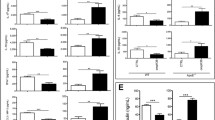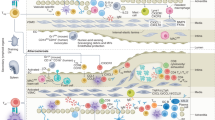Abstract
Background and Aims
The long-term effect of immune tolerance has not been explored so far in atherosclerosis. In the present study, we assessed the effect of mucosal tolerance to a multi antigenic construct expressing three peptides from ApoB, HSP60, and outer membrane protein from Chlamydia pneumonia (AHC) for 30 weeks at every 6-week interval to understand the kinetics of immune modulation in disease progression. The safety profile of the molecule was also evaluated in mice.
Methods
Apobtm2SgyLdlrtm1Her/J mice (5–6 weeks) were orally dosed with multi antigenic construct (AHC) molecule on alternate days, followed by high-fat diet feeding to initiate atherosclerosis.
Results
Treated animals showed an efficient reduction in plaque growth and lipid accumulation at 6 weeks (49%, p < 0.01) and 12 weeks (42.3%, p < 0.01) which decreased to 29% (p = 0.0001) at 18 weeks and at later time points. Macrophage accumulation was significantly lower at all time points (53% at 12 weeks to 27% at 30 weeks). Regulatory T cells increased in the spleen following treatment until 12 weeks (week 0 (2.57 ± 0.18 vs. 6.36 ± 0.03, p = 0.02), week 6 (4.52 ± 0.2 vs. 8.87 ± 0.32, p = 0.02), and week 12 (8.74 ± 0.37 vs. 15.4 ± 0.27, p = 0.02)) but showed a decline later. A similar trend was observed with tolerogenic dendritic cells. We observed an increase in antibody levels to low-density lipoprotein and oxidized LDL at later stages. AHC molecule was found to be safe in acute and repeated dose toxicity studies.
Conclusions
Our results suggest that immune tolerance to AHC protein by oral administration is able to provide efficient atheroprotection up to 18 weeks and moderately at later stages. Apart from immune regulatory cells, protective antibodies may also have a role in controlling atherosclerosis.






Similar content being viewed by others
References
Fredrikson GN, Soderberg I, Lindholm M, Dimayuga P, Chyu KY, Shah PK, et al. Inhibition of atherosclerosis in apoE-null mice by immunization with apoB-100 peptide sequences. Arterioscler Thromb Vasc Biol. 2003;23(5):879–84.
Binder CJ, Horkko S, Dewan A, Chang MK, Kieu EP, Goodyear CS, et al. Pneumococcal vaccination decreases atherosclerotic lesion formation: molecular mimicry between Streptococcus pneumoniae and oxidized LDL. Nat Med. 2003;9(6):736–43.
Jun L, Jie L, Dongping Y, Xin Y, Taiming L, Rongyue C, et al. Effects of nasal immunization of multi-target preventive vaccines on atherosclerosis. Vaccine. 2012;30(6):1029–37.
Wick G, Knoflach M, Xu Q. Autoimmune and inflammatory mechanisms in atherosclerosis. Annu Rev Immunol. 2004;22:361–403.
Nilsson J, Hansson GK. Autoimmunity in atherosclerosis: a protective response losing control? J Intern Med. 2008;263(5):464–78.
Binder CJ, Papac-Milicevic N, Witztum JL. Innate sensing of oxidation-specific epitopes in health and disease. Nat Rev Immunol. 2016;16(8):485–97.
Miller YI, Choi SH, Wiesner P, Fang L, Harkewicz R, Hartvigsen K, et al. Oxidation-specific epitopes are danger-associated molecular patterns recognized by pattern recognition receptors of innate immunity. Circ Res. 2011;108(2):235–48.
Fontenot JD, Gavin MA, Rudensky AY. Foxp3 programs the development and function of CD4+CD25+ regulatory T cells. Nat Immunol. 2003;4(4):330–6.
Libby P, Lichtman AH, Hansson GK. Immune effector mechanisms implicated in atherosclerosis: from mice to humans. Immunity. 2013;38(6):1092–104.
Nilsson J, Fredrikson GN, Bjorkbacka H, Chyu KY, Shah PK. Vaccines modulating lipoprotein autoimmunity as a possible future therapy for cardiovascular disease. J Intern Med. 2009;266(3):221–31.
Binder CJ, Hartvigsen K, Witztum JL. Promise of immune modulation to inhibit atherogenesis. J Am Coll Cardiol. 2007;50(6):547–50.
Mor A, Planer D, Luboshits G, Afek A, Metzger S, Chajek-Shaul T, et al. Role of naturally occurring CD4+ CD25+ regulatory T cells in experimental atherosclerosis. Arterioscler Thromb Vasc Biol. 2007;27(4):893–900.
Mallat Z, Gojova A, Brun V, Esposito B, Fournier N, Cottrez F, et al. Induction of a regulatory T cell type 1 response reduces the development of atherosclerosis in apolipoprotein E-knockout mice. Circulation. 2003;108(10):1232–7.
Herbin O, Ait-Oufella H, Yu W, Fredrikson GN, Aubier B, Perez N, et al. Regulatory T-cell response to apolipoprotein B100-derived peptides reduces the development and progression of atherosclerosis in mice. Arterioscler Thromb Vasc Biol. 2012;32(3):605–12.
Wigren M, Kolbus D, Duner P, Ljungcrantz I, Soderberg I, Bjorkbacka H, et al. Evidence for a role of regulatory T cells in mediating the atheroprotective effect of apolipoprotein B peptide vaccine. J Intern Med. 2011;269(5):546–56.
Klingenberg R, Ketelhuth DF, Strodthoff D, Gregori S, Hansson GK. Subcutaneous immunization with heat shock protein-65 reduces atherosclerosis in Apoe(−)/(−) mice. Immunobiology. 2012;217(5):540–7.
Lu X, Xia M, Endresz V, Faludi I, Szabo A, Gonczol E, et al. Impact of multiple antigenic epitopes from ApoB100, hHSP60 and Chlamydophila pneumoniae on atherosclerotic lesion development in Apob(tm2Sgy)Ldlr(tm1Her) J mice. Atherosclerosis. 2012;225(1):56–68.
Chyu KY, Zhao X, Dimayuga PC, Zhou J, Li X, Yano J, et al. CD8+ T cells mediate the athero-protective effect of immunization with an ApoB-100 peptide. PLoS One. 2012;7(2):e30780.
Tse K, Gonen A, Sidney J, Ouyang H, Witztum JL, Sette A, et al. Atheroprotective vaccination with MHC-II restricted peptides from ApoB-100. Front Immunol. 2013;4:493.
Hermansson A, Ketelhuth DF, Strodthoff D, Wurm M, Hansson EM, Nicoletti A, et al. Inhibition of T cell response to native low-density lipoprotein reduces atherosclerosis. J Exp Med. 2010;207(5):1081–93.
Zhong Y, Tang H, Wang X, Zeng Q, Liu Y, Zhao XI, et al. Intranasal immunization with heat shock protein 60 induces CD4(+) CD25(+) GARP(+) and type 1 regulatory T cells and inhibits early atherosclerosis. Clin Exp Immunol. 2016;183(3):452–68.
Long J, Lin J, Yang X, Yuan D, Wu J, Li T, et al. Nasal immunization with different forms of heat shock protein-65 reduced high-cholesterol-diet-driven rabbit atherosclerosis. Int Immunopharmacol. 2012;13(1):82–7.
Mundkur L, Mukhopadhyay R, Samson S, Varma M, Kale D, Chen D, et al. Mucosal tolerance to a combination of ApoB and HSP60 peptides controls plaque progression and stabilizes vulnerable plaque in Apob(tm2Sgy)Ldlr(tm1Her)/J mice. PLoS One. 2013;8(3):e58364.
Mundkur L, Ponnusamy T, Philip S, Rao LN, Biradar S, Deshpande V, et al. Oral dosing with multi-antigenic construct induces atheroprotective immune tolerance to individual peptides in mice. Int J Cardiol. 2014;175(2):340–51.
Thota LN, Ponnusamy T, Philip S, Lu X, Mundkur L. Immune regulation by oral tolerance induces alternate activation of macrophages and reduces markers of plaque destabilization in Apobtm2Sgy/Ldlrtm1Her/J mice. Sci Rep. 2017;7(1):3997.
Sutcliffe MJ, Jaseja M, Hyde EI, Lu X, Williams JA. Three-dimensional structure of the RGD-containing neurotoxin homologue dendroaspin. Nat Struct Mol Biol. 1994;1(11):802–7.
Kumar PU, Kumar BD, Annapurna VV, Krishna TP, Kalyanasundaram S, Suresh P, et al. Nonclinical toxicology study of recombinant-plasmid DNA anti-rabies vaccines. Vaccine. 2006;24(15):2790–8.
Misra N, Bayry J, Lacroix-Desmazes S, Kazatchkine MD, Kaveri SV. Cutting edge: human CD4+CD25+ T cells restrain the maturation and antigen-presenting function of dendritic cells. J Immunol. 2004;172(8):4676–80.
Qureshi OS, Zheng Y, Nakamura K, Attridge K, Manzotti C, Schmidt EM, et al. Trans-endocytosis of CD80 and CD86: a molecular basis for the cell-extrinsic function of CTLA-4. Science. 2011;332(6029):600–3.
Libby P, Ridker PM, Hansson GK, Leducq Transatlantic Network on A. Inflammation in atherosclerosis: from pathophysiology to practice. J Am Coll Cardiol. 2009;54(23):2129–38.
Greaves DR, Channon KM. Inflammation and immune responses in atherosclerosis. Trends Immunol. 2002;23(11):535–41.
Nilsson J. Can antibodies protect us against cardiovascular disease? EBioMedicine. 2016;9:29–30.
Rothstein TL. Natural antibodies as rheostats for susceptibility to chronic diseases in the aged. Front Immunol. 2016;7:127.
Faria-Neto JR, Chyu KY, Li X, Dimayuga PC, Ferreira C, Yano J, et al. Passive immunization with monoclonal IgM antibodies against phosphorylcholine reduces accelerated vein graft atherosclerosis in apolipoprotein E-null mice. Atherosclerosis. 2006;189(1):83–90.
Binder CJ, Shaw PX, Chang MK, Boullier A, Hartvigsen K, Horkko S, et al. The role of natural antibodies in atherogenesis. J Lipid Res. 2005;46(7):1353–63.
Binder CJ, Silverman GJ. Natural antibodies and the autoimmunity of atherosclerosis. Springer Semin Immunopathol. 2005;26(4):385–404.
Shaw PX, Horkko S, Chang MK, Curtiss LK, Palinski W, Silverman GJ, et al. Natural antibodies with the T15 idiotype may act in atherosclerosis, apoptotic clearance, and protective immunity. J Clin Invest. 2000;105(12):1731–40.
George J, Afek A, Gilburd B, Levkovitz H, Shaish A, Goldberg I, et al. Hyperimmunization of apo-E-deficient mice with homologous malondialdehyde low-density lipoprotein suppresses early atherogenesis. Atherosclerosis. 1998;138(1):147–52.
Chang MK, Binder CJ, Miller YI, Subbanagounder G, Silverman GJ, Berliner JA, et al. Apoptotic cells with oxidation-specific epitopes are immunogenic and proinflammatory. J Exp Med. 2004;200(11):1359–70.
Que X, Hung MY, Yeang C, Gonen A, Prohaska TA, Sun X, et al. Oxidized phospholipids are proinflammatory and proatherogenic in hypercholesterolaemic mice. Nature. 2018;558(7709):301–6.
Murdaca G, Spano F, Cagnati P, Puppo F. Free radicals and endothelial dysfunction: potential positive effects of TNF-alpha inhibitors. Redox Rep. 2013;18(3):95–9.
Lehrer-Graiwer J, Singh P, Abdelbaky A, Vucic E, Korsgren M, Baruch A, et al. FDG-PET imaging for oxidized LDL in stable atherosclerotic disease: a phase II study of safety, tolerability, and anti-inflammatory activity. J Am Coll Cardiol Img. 2015;8(4):493–4.
Schiopu A, Frendeus B, Jansson B, Soderberg I, Ljungcrantz I, Araya Z, et al. Recombinant antibodies to an oxidized low-density lipoprotein epitope induce rapid regression of atherosclerosis in apobec-1(−/−)/low-density lipoprotein receptor(−/−) mice. J Am Coll Cardiol. 2007;50(24):2313–8.
Acknowledgments
We are extremely grateful to late Professor Vijay V Kakkar, Scientific Chairman, Thrombosis Research Institute, Bangalore for his constant encouragement and support. The support from Bharathi foundation for PhD students is gratefully acknowledged.
Funding
This work was supported by Thrombosis Research Institute, London and Bangalore, and Department of Biotechnology, Ministry of Science and Technology, Government of India (BT/01/CDE/08/07), and Bharathi Mittal foundation.
Author information
Authors and Affiliations
Contributions
The study was planned by LM and LNT. Experiments were carried out by LNT. The first draft of the manuscript was written by LNT. The manuscript was improvised by LM and LNT.
Corresponding author
Ethics declarations
Conflict of Interest
The authors declare that they have no conflict of interest.
Ethical Approval
Animal studies were performed and followed according to the CPCSEA guidelines and institute animal ethics committee.
Additional information
Publisher’s Note
Springer Nature remains neutral with regard to jurisdictional claims in published maps and institutional affiliations.
Electronic supplementary material
ESM 1
(DOCX 451 kb)
Rights and permissions
About this article
Cite this article
Thota, L.N., Ponnusamy, T., Lu, X. et al. Long-Term Efficacy and Safety of Immunomodulatory Therapy for Atherosclerosis. Cardiovasc Drugs Ther 33, 385–398 (2019). https://doi.org/10.1007/s10557-019-06890-0
Published:
Issue Date:
DOI: https://doi.org/10.1007/s10557-019-06890-0




